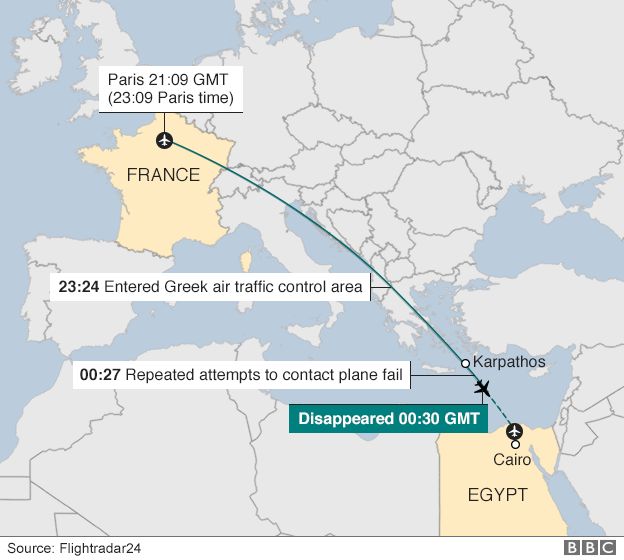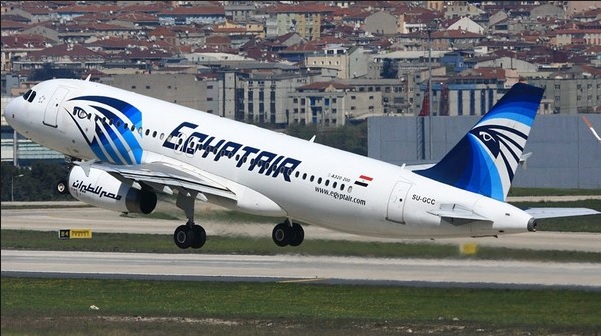BBC report – An EgyptAir flight from Paris to Cairo made two sharp turns before plunging into the Mediterranean Sea, Greece’s defence minister says.
Panos Kammenos said the Airbus A320 had “turned 90 degrees left and then a 360-degree turn to the right”, before disappearing from radar.
Egypt’s civil aviation minister has said the possibility of a terror attack is stronger than technical failure.
Vice-President Ahmed Adel later told CNN wreckage had been found in the sea.
The operation “is turning into a search and recovery”, he said.
Earlier search teams in the area were reported to have sighted debris, including life jackets, from the plane.
“There have been finds south-east of Crete, inside the Cairo flight information area,” Greek army general staff spokesman Vassilis Beletsiotis told AFP news agency.
The search in seas south of the Greek island of Karpathos involves Greek and Egyptian naval forces, and the British Royal Air Force.
Sixty-six people were on board Flight MS804, most of them from Egypt and France. A Briton was among the passengers.

Of those on the plane, 56 were passengers, seven were crew members and three were security personnel.
Relatives of some of those on board are being flown from Paris Charles de Gaulle airport to Cairo.
Flight MS804 left Charles de Gaulle at 23:09 local time on Wednesday (21:09 GMT) and was scheduled to arrive in the Egyptian capital soon after 03:15 local time on Thursday.
EgyptAir said the plane had been flying at 37,000ft (11,300m) when it disappeared from radar shortly after entering Egyptian airspace.
Greek aviation officials say air traffic controllers spoke to the pilot when he entered Greek airspace and everything appeared normal.
They tried to contact him again at 02:27 Cairo time, as the plane was set to enter Egyptian airspace, but “despite repeated calls, the aircraft did not respond”. Two minutes later it vanished from radar.


Mr Kammenos said: “The picture we have at the moment on the accident as it emerges from the Greek air force operations centre is that the aircraft was approximately 10-15 miles inside the Egyptian FIR [flight information region] and at an altitude of 37,000 feet.
“It turned 90 degrees left and then a 360-degree turn toward the right, dropping from 37,000 to 15,000 feet and then it was lost at about 10,000 feet.”
Egyptian Aviation Minister Sherif Fathi said: “Let’s not try to jump to the side that is trying to identify this as a technical failure – on the contrary.
“The situation may point – and I say ‘may’ because I don’t want to speculate and I don’t want to go to assumptions like others – but if you analyse the situation properly, the possibility of having a different action, or having a terror attack, is higher than the possibility of having a technical [fault].”
Initially, the aircraft seemed to drop off the radar at 37,000 feet, suggesting a sudden break-up. It’s very rare for modern planes to simply break apart in mid air, but not impossible.
But then the Greek defence minister described the aircraft making sharp turns and dropping height quickly. Which suggests it was intact for longer.
Either way, it does not rule out either an accident, or something more sinister.
Even in the worst emergencies, pilots tell me they should have time to call for help, once they’ve got to grips with the problem. But not always.
French President Francois Hollande said he was keeping an open mind about the cause: “We will draw conclusions when we have the truth about what happened.
“Whether it was an accident, or whether it was – and it’s something that is on our minds – terrorism.”
Flightradar24 listed details of the plane’s journey on Wednesday which showed it had flown from Asmara, in Eritrea, to Cairo, then on to Tunis, in Tunisia, before heading, via Cairo, to Paris.
Aviation analyst Alex Macheras told the BBC that Airbus A320s were regularly used for short-haul budget flights and had “an amazing safety record”.
In March, an EgyptAir plane was hijacked and diverted to Cyprus. The attacker later surrendered and all hostages were released. … Read More
